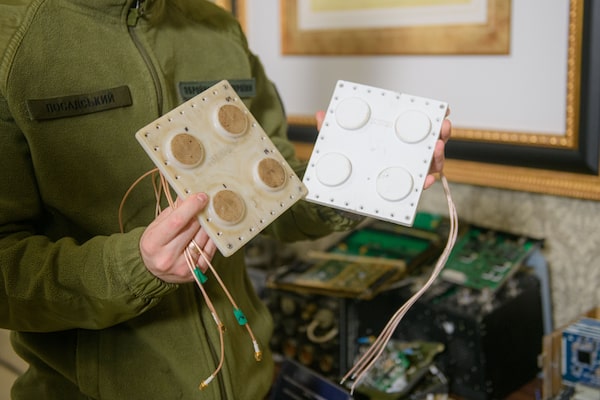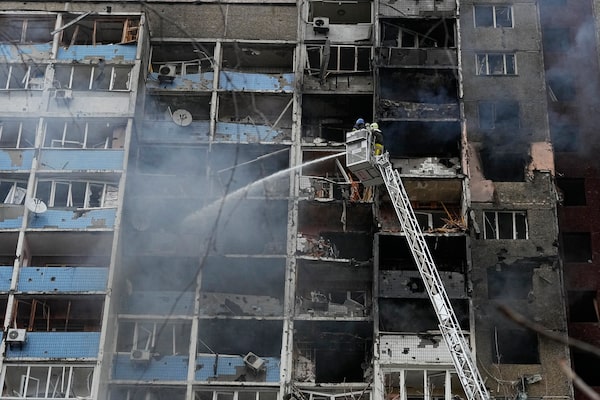Newest Russian drones feature knock-off versions of Canadian technology, Ukrainian officials say

Lt. Ivan Posadskyi shows a Canadian-made antenna found in a destroyed Shahed drone, as well as a Russian copy of the same equipment (left is the Canadian one), on Feb. 25.OLGA IVASHCHENKO/THE GLOBE AND MAIL/THE GLOBE AND MAIL
After more than a year of seeing Canadian-made parts turn up inside explosive drones striking Ukrainian cities, military scientists in Kyiv say newer versions of the Iranian-designed Shaheds no longer use antenna equipment produced by Ottawa-based Tallysman Wireless.
But that’s not entirely good news. First Lieutenant Ivan Posadskyi said Russia – which started launching the drones at Ukrainian targets in the summer of 2022 – has developed a knock-off of Tallysman’s ceramic antenna that helps the kamikaze aircraft evade detection by Ukraine’s air defences. Russia is now producing its own versions of the Shahed-136 drones, and China appears to have played a helping hand in that effort, said Lt. Posadskyi, a member of Ukraine’s Central Scientific Research Institute of Armament and Military Equipment.
“We’re not seeing Tallysman equipment anymore. Those were the first versions. The Russians are now manufacturing the Shaheds in Russia. The same design, same approach, just the components are different. The Russian one is better, because they’ve upgraded it.”
Tallysman’s equipment, he said, “basically lit the idea for the Russians of making their own models with a similar pattern and design.”
Shahed drones haunt Ukraine’s cities on almost nightly basis – making a buzzing sound that has caused Ukrainians to bitterly nickname them “mopeds” – with Russia often using them to exhaust Ukraine’s air defences before launching salvos of cruise and ballistic missiles. The Ukrainian government said at the end of 2023 that 3,700 Shahed drones had been fired at the country in the 16 months since Russia began using them.

Kyrylo Budanov, Chief of the Defence Intelligence of Ukraine, in Kyiv, on Feb. 25.OLGA IVASHCHENKO/THE GLOBE AND MAIL
In 2022, Tallysman president Gyles Panther said the company had “become painfully aware” of how its technology was being “misused” and was in no way complicit in how its antennas ended up in the hands of Iranian scientists. The same type of antenna components made by Tallysman, which has since been purchased by the Ottawa-based Calian Group, can be found in consumer satellite navigation devices.
Asked about this latest development, Calian Group attributed the lack of Talisman gear in newer Shahed drones to efforts designed to stop its components from being obtained by the Iranian manufacturers.
“We are encouraged that the measures we put in place are working and are pleased that our collective efforts have made a positive impact in ensuring that our products are exclusively sold to legitimate entities and not used for malevolent purposes,” Darrell Wellington, vice-president of Calian GNSS, a division of Calian Group, said in a statement.
Calian has been working with the Canadian government and distributors to prevent its components from being used in an unauthorized manner, ensuring products are “exclusively sold to legitimate entities” and illicit supply channels are shut down.
The story of how Tallysman equipment was used, and then copied, by the Russian military shows the need for Ukraine’s international allies to tighten restrictions on the export of dual-use technology, said Oleh Nikolenko, a spokesperson for Ukraine’s Foreign Ministry.
A police officer inspects parts of an unmanned aerial vehicle (UAV), what Ukrainian authorities consider to be an Iranian made suicide drone Shahed-136, at a site of a Russian strike on fuel storage facilities, amid Russia's attack on Ukraine, in Kharkiv, on Oct. 6, 2022.STRINGER/REUTERS
“The Russians find where these components are and then they increase their imports of this equipment – not exported straight to Russia, but through third countries, mostly Central Asian countries,” he said. “We need to destroy the schemes that are being used by the Russians.”
Ending such exports, he added, is just as important as sending more air defence equipment to Ukraine since it would significantly decrease Russia’s ability to produce new munitions.
Ukraine’s military research unit believes the knock-off antennas used in the Russian-made Shaheds are manufactured in China. It says they have also been found in glide bombs – which can be dropped at a distance and then remotely directed toward their target – that Russia has been using to devastating affect along the front lines in the east and south of Ukraine. Military analysts say Russia’s intensive use of these bombs – reportedly hundreds in a single day – played a key role in forcing Ukrainian troops to abandon the shattered city of Avdiivka earlier this month after a 10-year battle.
The sophisticated Tallysman antennas and their knock-offs perform the same task: They enable an unmanned aerial vehicle to receive satellite navigation signals on several frequencies at once. That function, designed to help commercial UAVs navigate an urban terrain, makes it difficult for Ukraine’s air defence to jam the incoming Shaheds.
The best way to fight a Shahed is to shut it down before it reaches its destination, Lt. Posadskyi said. “Once it reaches a city, it’s a hell of a problem.”

Firefighters work to extinguish a fire in an apartment building after Russian attack in Kyiv, on Feb. 7.EFREM LUKATSKY/THE ASSOCIATED PRESS
But the Russian-produced Shaheds have an additional antenna – one that is very simple and easy to jam. When this happens, it alerts the drone operator that the craft has been discovered by Ukrainian radar. The drone’s central processing unit then switches to other frequencies – using the cloned Tallysman antenna – as it continues toward its target.
“It makes the Shahed almost foolproof to jamming,” Lt. Posadskyi said.
Mr. Wellington said the newly discovered gear was not copied from Calian technology. “It’s important to note that these highly sophisticated anti-jamming and null-steering systems have not originated or been duplicated from Tallysman’s antennas. Antennas play a passive role in the complex anti-jamming systems of a drone, alongside an array of electronic configurations, receivers and algorithms.”
His company is willing to lend its expertise on global navigation satellite systems to help Ukraine defeat the new technology, he added.
Another difference with the newer Shaheds is that they are made from carbon fibre, which is radar-absorbent. This makes the craft less visible on radar because it doesn’t bounce a ping back to air defence teams scanning the skies. The Russian-made UAVs are also painted black on the bottom to make it harder for spotlights to find them once they enter cities.
Lt. Posadskyi was speaking on Sunday on the sidelines of a forum in Kyiv, where the Central Scientific Research Institute of Armament and Military Equipment had set up a two-table display of Western-produced military parts it had found in destroyed Russian weaponry.
The wreckage of a destroyed bridge leading to the village of Bohorodychne in eastern Ukraine on Feb. 29.DAVID GUTTENFELDER/THE NEW YORK TIMES NEWS SERVICE
A database created by Ukraine’s National Agency on Corruption Prevention lists Tallysman technology as having turned up in three different Iranian-designed drones used in the war: Shahed-136, Shahed-131 and Mojaher-6, as well as the Russian-made Orlan-10 UAV.
Cable equalizers produced by Gennum Corp., based in Burlington, Ont., have also been found inside the Mojaher-6, while converters and circuits manufactured by Montreal-based Aimtec were discovered in several pieces of Russian military hardware, including electronic warfare systems, armoured vehicles and self-propelled artillery.
Canada has strict sanctions on the export of military equipment to both Russia and Iran, but the commercial electronics parts produced by Tallysman, Gennum and Aimtec are not covered by the restrictions. Aimtec recently said its products are not meant for military purposes and that it asks distributors to respect U.S. and Canadian trade compliance regulations and requires consignees to whom the product is delivered to sign statements saying the items won’t be sold to military clients. It said it also conducts security checks regularly, consulting lists of entities under trade restrictions by the United States or Canada to ensure compliance.
Around 60 per cent of the gear on display at Lt. Posadskyi’s table was originally manufactured in the United States.
He said he had developed grudging respect for his adversaries in this war-within-a-war of military innovation and counter-innovation.
“I’m impressed with their creativity. It’s hard to say I’m impressed by their technology because Western samples of equipment and weapons are way more sophisticated and way more efficient and way more precise.”
Holding up one of the knock-off versions of the Tallysman antenna, Lt. Posadskyi said it was nonetheless “impressive how the Russians, given the resources that they have and despite all the limitations that have been imposed on them, are still managing to produce this.”
No comments:
Post a Comment